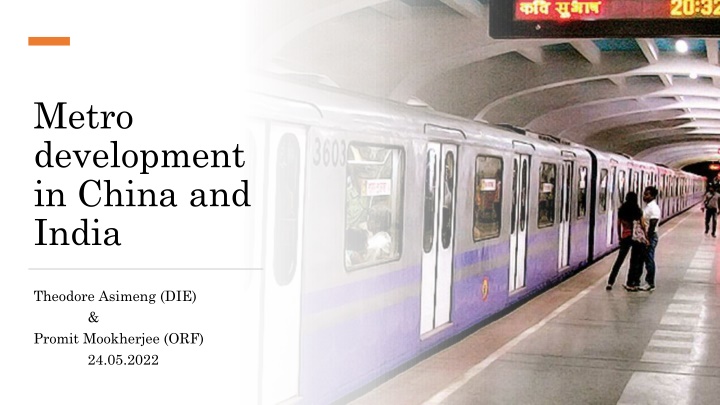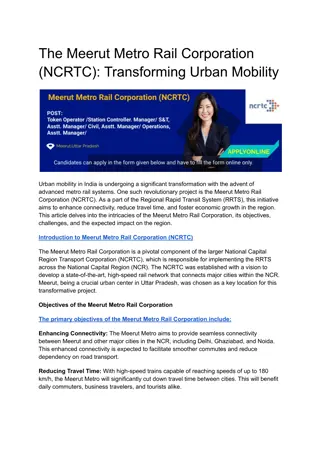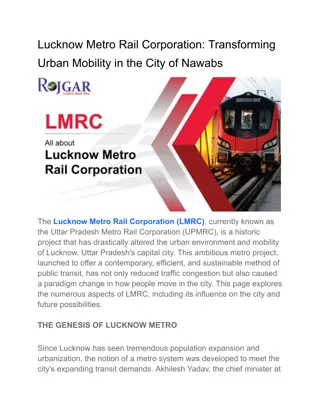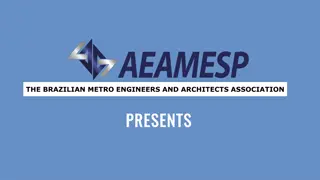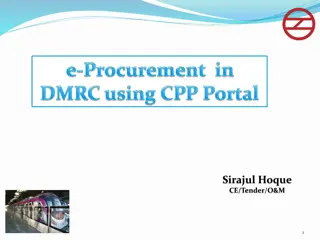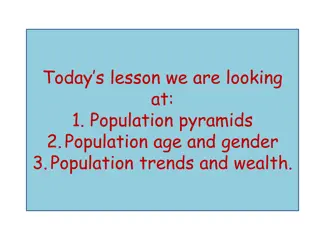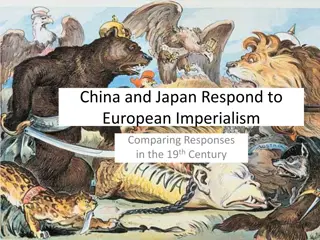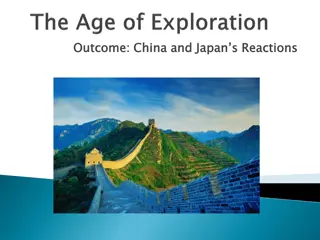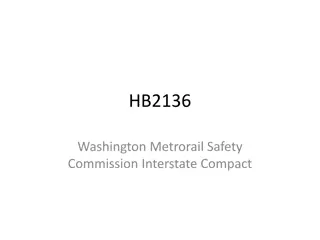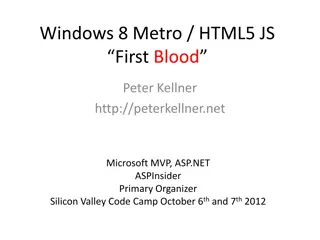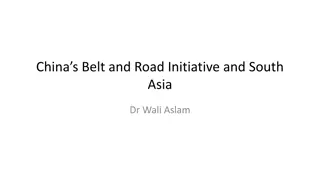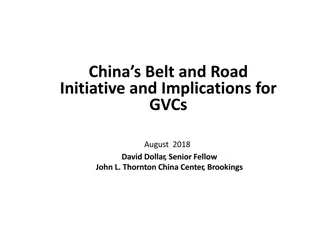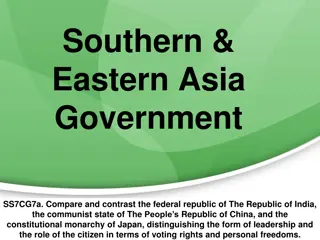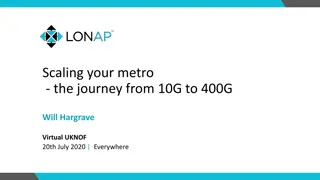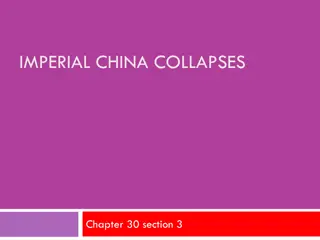Evolution of Metro Development in China and India
The article explores the importance of metro systems, challenges in implementation, and how China and India have developed as global leaders in metro infrastructure. It delves into China's strategic policies, technological advancements, and organizational structures that have propelled it to the forefront of metro development. Meanwhile, India's rapid growth in metro systems, especially in smaller cities, reflects a shift towards modernized mass transit solutions. Lessons from both countries offer valuable insights for sustainable urban development.
Download Presentation

Please find below an Image/Link to download the presentation.
The content on the website is provided AS IS for your information and personal use only. It may not be sold, licensed, or shared on other websites without obtaining consent from the author.If you encounter any issues during the download, it is possible that the publisher has removed the file from their server.
You are allowed to download the files provided on this website for personal or commercial use, subject to the condition that they are used lawfully. All files are the property of their respective owners.
The content on the website is provided AS IS for your information and personal use only. It may not be sold, licensed, or shared on other websites without obtaining consent from the author.
E N D
Presentation Transcript
Metro development in China and India Theodore Asimeng (DIE) & Promit Mookherjee (ORF) 24.05.2022
Outline Importance of metro Why is it difficult to implement? How has China become a global leader in Metro development? How is India rapidly developing metro? Lessons from both cases
Importance of Metro Trains move large number of people than any other land transport system Trains provide safe, comfortable and reliable transport services Trains emit low CO2 emissions if the energy source is renewable
Why is it difficult to implement Metro Metro technology sub-system 9 8 7 6 Level of technology difficulty 5 4 3 2 1 0 Civil eng. above ground Railway track Vehicle body Bogies (wheels, brake parts, etc.) Line-side electric system Civil eng. below ground Propulsion system Signalling and control (ATS, CBTC)
How China has become a global leader in Metro development Policy The 5 year development plans The industrial policy Made in China . Technology transfer of rolling stock technology Ministry of Railways Manufacturing Companies Universities Research Institutes Implementation 3 stages of rail development A. 1969-1995: initiation stage B. 1998-2009: growth stage C. 2010 date: metro construction boom Other s BJTU SWJTU TU CNR CSR CARS CSR Zhuzhou Nanjing Zhuzhou Sifang Changchung Tangshan Organisation structure of R&D and manufacturing institutions in China
How China has become a global leader in rail development Global metro development in 2018 (960 Km) 7000 4%2% 1% 7% 5850 6000 Asia-Pacific MENA & Africa 5000 Eurasia South America Operational (Km) 4000 Europe 3100 86% 3000 2000 Component % local manufacturing Rolling stock 100% 870 1000 Telecom 100% 101 24 0 Signalling 100% 1969 2000 2010 2015 2020 YEAR Civil works 100% Electrical Close to 100%
Rapid Growth in Metro Systems Rapid urbanization leading to 10-fold increase in motorized vehicles since 1990. Metros have emerged as the most popular mass transit system Modernized metro systems began with Delhi Metro in 2002. Rapid growth since then, presently 18 cities have functional metros covering around 750 operational km Increasing demand for metros in smaller cities (population below 5 million) Recent examples are Bhopal, Agra, Surat, among others. Operational km 1800 2025:27 cities 1700 1600 1400 1200 2021: 18 cities 1000 733 800 600 2014:5 cities 2002: 2 cities 248 400 1984:1 city 35 200 3.4 0 1980 1985 1990 1995 2000 2005 2010 2015 2020 2025 2030 Rapidly expanding metro systems in India
Metro Policy In India Metro s are extremely capital intensive, costs have ranged from USD 30 million to USD 74 million. Objectives Mandated actions Systems Approach to Metro Planning Comprehensive Mobility Plan (CMP) Unified Metropolitan Transit Authority (UMTA) Alternatives analysis Detailed project report Since 2010, cumulative investment in metros has been to the tune of USD 257 billion. Reducing cost of metros Compulsory indigenization Phased increases in mandated local content in tenders Standardization of sub-systems Projected expenditure of USD 38 billion in the next five years Enhancing revenues Plan for land value capture financing Comprehensive feeder systems Transit oriented development Public-private partnerships 18 out of 21 metros financed jointly by Centre and State aided by concessional loans from foreign development organizations. Metro Policy 2017 lays down criteria for metro projects to get approval and central support Mandated measures in the Metro Policy It institutionalizes certain measures for making metro projects more tenable: Focus on industrialization
Prioritizing domestic capabilities Whereas metro growth is happening in the developing world, technologies for metro sub- systems are largely controlled by firms in the developed world Many countries focusing on adapting industrial policies to build up local capabilities for manufacturing and also design their own technologies India has followed a two-fold strategy: Mandated local manufacturing and local content in the procurement process Standardisation of sub-systems to concentrate demand Mandates limited to materials used in the production process. No direct government intervention in technology acquisition or favouring particular model of tech transfer. Component Mandated local content Rolling stock 60% Telecom 50% Signalling 50% Civil works 90% 80%(underground) (elevated), Electrical 50% Mandated local content for different sub-systems
Rolling Stock Company Coaches Supplied Local Facilities Technology Transfer From being completely import dependent, India has taken great strides in domestic production. Alstom- Bombardier 2500 Two facilities manufacturing Initially dependent on parent company. Mixture of FDI and domestic investment (France) Recently lot of focus on India designs and setting up engineering facilities in India specific Two-component manufacturing facilities Cost of rolling stock down from INR 13-15 crore per coach to under INR 10 crore Driving force behind localization has been increased competition. Firms have started focussing on developing India specific designs to lower costs. CRRC (China) 598 Two facilities upcoming All manufactured China trains in Bharat Movers (India) Earth Limited 1500 One facility Design outsourced to foreign firms aspects Design capacity still lacking for propulsion systems Titagarh-Firema (India) 102 One facility Titagarh Italian Firema SPA to gain access to technology bought company Multiple models of technology development and transfer creating a vibrant ecosystem their Snapshot of rolling stock manufacturing capacity in India
Signaling and communication Metro rail requires sophisticated communication based train control (CBTC) systems Sub-system Automatic Supervision Equipment Description - Train (ATS) Installed at communication center and wayside. Identifies tracks and displays trains to the control center - Primary supplier of CBTC has been Alstom and Siemens, no local capabilities for developing these systems Wayside Equipment - Network of controllers electronic processors installed on the track Provides positioning reference to train- borne equipment Processor-based controllers, measurement equipment, and sensors for determining the location Responsible for train location, speed enforcement, and function of ATS Located at the control center, wayside, and on-board the train Performs data communication within the train and with the other data centres based on Developing ATS system is highly capital and skill intensive, low incentive for local production - Train-borne equipment - speed Thus, only 50% mandated local content, restricted largely to the hardware - Data equipment communication - Delhi metro first to develop indigenous CBTC system, i-ATS, in trial phase - Collaborative effort between metro authority and research institutions. Components of CBTC systems Successful collaboration between govt, industry and research community
Drivers of Technology Development Technology development policies can be broadly grouped: Selective: purposive targeting of certain activities or direct government involvement in technology transfer Functional: improving the market and leaving it free to operate or influencing the direction of growth through the setting of specific national priorities Indian policy has focused on setting priorities without direct government involvement in technology transfer. Drivers of domestic manufacturing and technology transfer: Scale Competition Relative favorable conditions for FDI Existing capacity as supplier to Railways Stable policy environment Standardization Local content mandates (not as important)
